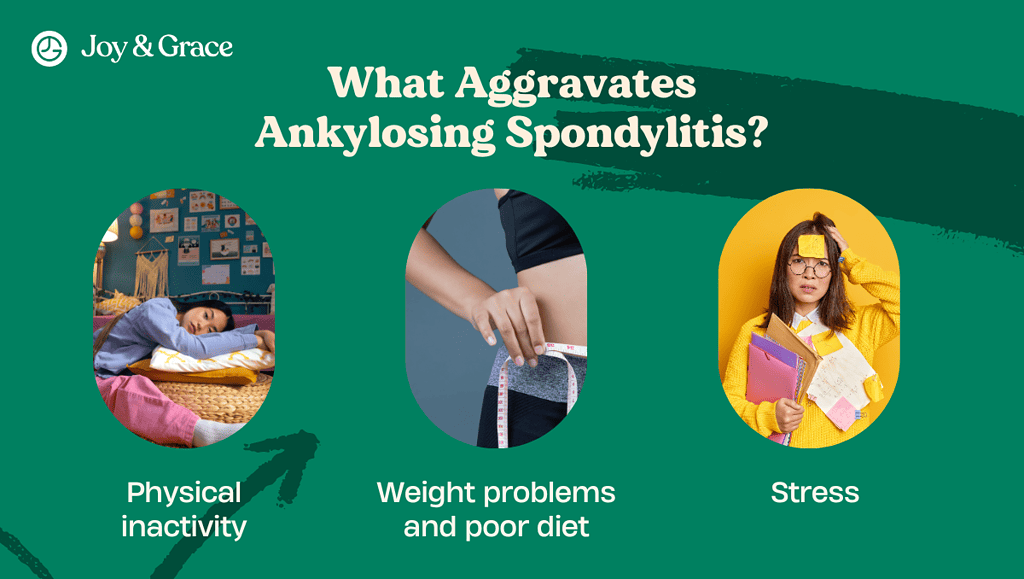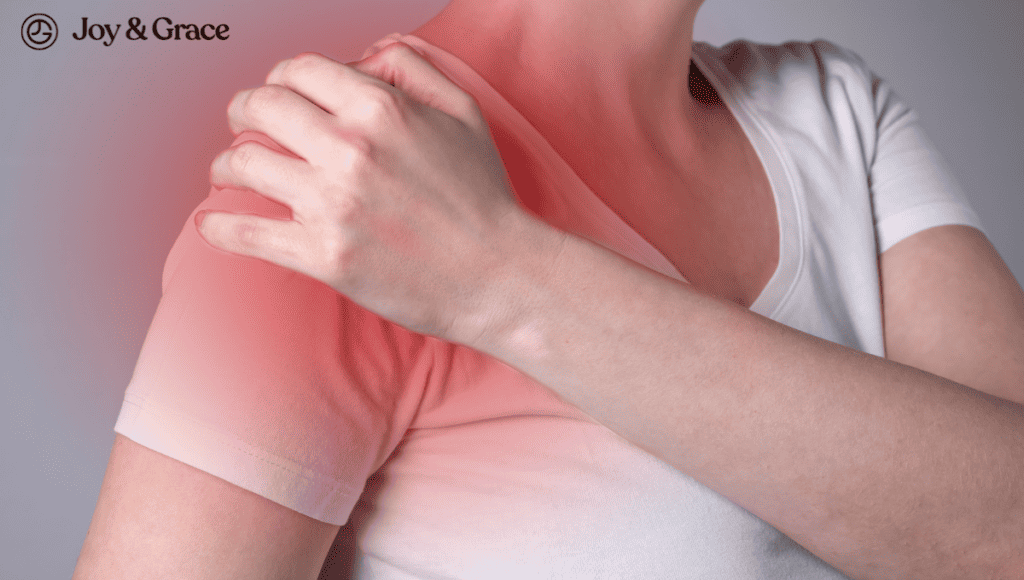The Spondylitis Association of America says that up to 3.2 million Americans have ankylosing spondylitis. Ankylosing spondylitis (AS) is a rare type of arthritis that mostly affects the joints and ligaments of your spine. If you have this disease, your bones and joints fuse together (“ankylosing”) due to inflammation in your spine (“spondylitis”).
Although it mainly affects your spine, it can also cause inflammation in other areas of your body, especially the hips and shoulders. Shoulder pain is a common symptom of the disease but is also common in other conditions. So how can you tell if ankylosing spondylitis is causing the pain in your shoulder? We've gathered information from studies and expert organizations to help you answer the question.
Can Ankylosing Spondylitis Cause Neck And Shoulder Pain?
Ankylosing spondylitis causes the joints and bones of your spine to be inflamed. Because of this, it is no surprise that the most common symptom patients experience is back and neck pain. Up to 70% of people with the disease will have neck pain.
And while the neck and back are the main targets of the disease, other areas of your body aren’t spared from the inflammation. Shoulder pain is actually a very common symptom if you have ankylosing spondylitis.
According to a study, 56% of patients with ankylosing spondylitis will have shoulder pain. The reason why ankylosing spondylitis causes shoulder pain can be due to enthesitis.
Enthesitis is the inflammation of the enthesis or the site where tendons and ligaments attach to your bones. Enthesitis can occur in any part of your body, including the shoulders, knees, elbows, and ankles.
Aside from enthesitis, it can also cause inflammation of the joints, tendons, and muscles of the shoulders. The inflammation may also cause the bones of the shoulders to break down, resulting in shoulder pain.
Can Ankylosing Spondylitis Cause Severe Shoulder Pain?
Yes, ankylosing spondylitis can indeed cause severe shoulder pain. In one study, up to 15.2% of patients had severe shoulder pain, while 13.8% had very severe shoulder pain. The presence of shoulder pain also means you have a higher chance of experiencing pain in your hips and other joints, too. Aside from the pain, your shoulders may also be stiff and unable to move.
The severe shoulder pain may be due to inflammation of other tissues of the shoulder joint. One study found that patients with ankylosing spondylitis are more likely to develop a “frozen shoulder.” Frozen shoulders, or adhesive capsulitis, can come in the form of severe shoulder pain. The pain can be so severe that you won’t be able to move your shoulders at all.
What Does The Pain Of Ankylosing Spondylitis Feel Like?

Doctors usually describe the pain as “inflammatory.” Meanwhile, people describe the pain as an ache or sharp stab. The pain may come and go or may be persistent. Stiffness can also go with shoulder pain. This stiffness can cause you to avoid movement, making the pain even worse.
For doctors to consider ankylosing spondylitis, your pain should meet at least four of the following criteria:
- Pain that appears suddenly
- Improvement with exercise
- No improvement with rest
- Pain at night with improvement upon waking up and getting out of bed
- Symptoms started when you’re less than 40 years old
What Aggravates Ankylosing Spondylitis?

Even though Ankylosing Spondylitis is due to genetics, lifestyle factors may worsen symptoms. These include:
- Physical Inactivity
A sedentary lifestyle can make symptoms worse. The lack of movement can promote the settling of calcium deposits in your joints, making your joints more likely to fuse together. A lack of exercise can also cause your muscles to tighten, resulting in more stiffness and pain.
- Weight problems and Poor Diet
An unhealthy diet can promote inflammation and worsen symptoms. Increased weight and obesity can also aggravate your symptoms. The increased body mass can put more pressure on your bones and joints, leading to more pain and stiffness.
An increase in fat cells can also encourage inflammation. Fat cells can secrete adipokines, which promote inflammation.
If you do have the disease, it’s best to try and avoid or minimize these foods as they are the biggest culprits in causing inflammation:
- Sugar
- Animal Fats
- Processed foods
- Stress
Stress causes our bodies to go into flight-or-fight mode. This response causes the release of hormones that promote inflammation. This, along with tensed muscles, can cause more pain and stiffness.
What Relieves Shoulder Pain From Ankylosing Spondylitis?

If you are suffering from ankylosing spondylitis, the pain can be excruciating. But there are many ways to relieve shoulder pain and other body aches.
Exercise is important in treating ankylosing spondylitis. According to research, exercise greatly reduces pain and stiffness. This is because exercise can help counteract the loss of flexibility and mobility. Furthermore, exercise helps combat obesity and increased weight.
Aside from exercise, it is also important for you to practice good posture. It is a simple change you can make to help relieve shoulder pain and stiffness.
- Medication
Non-steroidal anti-inflammatory drugs (NSAIDs) are the first line of treatment for ankylosing spondylitis. Aside from addressing the pain, they also help relieve inflammation. Luckily for us, many of these drugs are available over the counter. These include naproxen (Aleve) and ibuprofen (Advil). You may also take acetaminophen (Tylenol).
You might also take prescribed drugs that inhibit the cytokines responsible for the inflammation. These drugs can help relieve your symptoms and stop the disease from getting worse.
- Heat Therapy
Heating pads (or warm baths) can help soothe sore muscles and joints from flare-ups. They can prevent stiffness after getting out of bed or sitting for long periods (like watching TV).
Check out our heating pad, chock-full of herbs to help you relax and relieve the pain. Make sure not to overdo it, though – too much heat may increase inflammation. Why can't this disease be more straightforward, right?
- Proper Diet
While there is no specific diet to treat ankylosing spondylitis, changing the food you eat can help manage the inflammation. According to registered dietitian Joyce Prescott, RD, “There’s no specific diet that can treat or cure AS. But an overall, healthy diet of simply prepared whole foods may positively impact inflammatory conditions like AS.”
The best diet is one that can help relieve your symptoms and maintain (and enjoy, too!). Here are some diets you can look into:
- Mediterranean diet
- Paleo Diet
- Low-Starch Diet
- Gluten-Free Diet
- Keto Diet
- Stress Management
As mentioned, stress is one of the main things that can worsen ankylosing spondylitis. Any activity that helps relieve stress can also help ease your symptoms. So use up all your vacation days at work, start a journal, or go to therapy.
Takeaway
Ankylosing spondylitis is a debilitating disease that can lead to fatal consequences.
Shoulder pain is one of the early symptoms of ankylosing spondylitis. But, as the disease progresses, this pain may radiate to other body areas.
The good news is that medications and lifestyle changes help with the disease. These can relieve symptoms and slow down disease progression. Check out our short list of exercises that may help relieve your shoulder pain.
If you found this article helpful, share it with your family and friends. Also, be sure to sign up for our newsletter so that we can keep you informed about our future articles.















